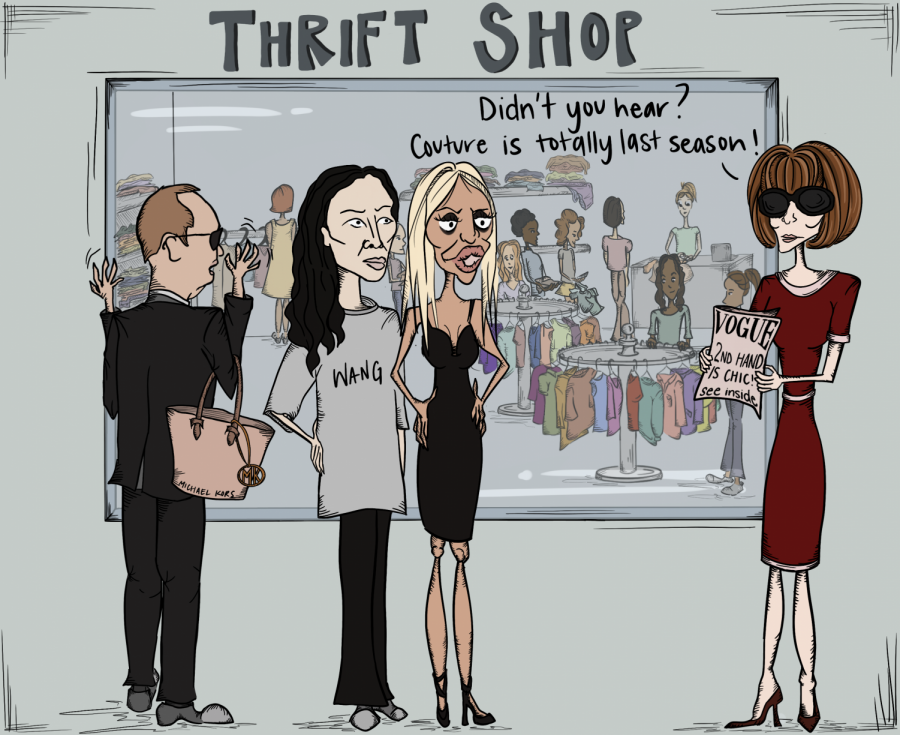Thrifting gets shifty
Buying secondhand poses moral issues
March 30, 2021
Walk down Haight Street and you’re bound to see gaggles of teenage girls holding bags stuffed with $5 or less items from Goodwill or Buffalo Exchange. While there is no denying that buying secondhand alleviates the toll that consumerism takes on the environment, thrifting raises other concerns — like whether or not financially secure individuals should be frequenting stores meant to help those who are less fortunate.
From upper income households, the percentage of teens who had purchased secondhand clothing was 46%, according to the semiannual “Taking Stock with Teens” report by Piper Sandler. Fifty-eight percent of teens have sold their used clothing to others.
Thrifting is desirable, not only because it offers a variety of clothes as low prices, but also because of its sustainable environmental impact. The fashion industry is responsible for about 10% of greenhouse gas emissions and 20% of wastewater globally, according to the United Nations Economic Commission for Europe. The industry is also known for the low wages and dangerous conditions that it imposes on its workers, specifically those manufacturing the clothing.
Thrifting, however, flouts the fashion industry faux pas by alleviating consumer concerns about the negative effects their clothing may be having. As it is all secondhand, thrifting recirculates clothes already in existence, limiting the landfill overfill and human rights violations that seem to follow the fashion industry.
Thrifting seems too good to be true — sustainable and accessible — but most of all affordable. And who doesn’t love a good bargain?
With many people out of a job due to the crippling economic effect of the pandemic, the low prices in thrift stores are more necessary than ever.
Thrifting’s ascension to popularity in more recent years is a result of by YouTubers like Emma Chamberlain who are known for making videos posting their thrifted “hauls” — bags upon bags of cheap, secondhand clothing. These videos have promoted the popularity of thrifting in demographics of all kinds, including wealthier individuals who can afford to buy even more.
The privilege is present on these Youtubers channels and inside thrift shops, with buyers treating stores like Goodwill, Crossroads, and the Salvation Army like the mall on Black Friday, leaving at the end of their shopping spree more bags than they can carry.
Many individuals have also begun buying in cheap clothing in bulk at thrift stores and reselling them for higher prices on online sites like Poshmark and Depop in the hopes of making money of their own. This kind of exploitation of the secondhand market detracts from its inherent accessibility.
It’s important to remember that many people actually depend on these stores for more than just fun vintage shopping. For some, these stores mean the difference between a new pair of jeans, or wearing last year’s worn-out ones again.
Thrift shops can be a great place to find unique, quirky pieces of clothing while staying eco-friendly — in moderation. There isn’t a need to buy more than you can carry. buying more makes it more likely that some of those clothes will end up in the trash, defeating the purpose of thrift shopping anyway.
Instead, if you can afford it, try shopping at sustainable brands like Reformation, Patagonia and Levi’s. Brands such as these offer quality apparel options that will last for a long time. And once you’re done wearing them, you can always donate them to a thrift store to give them new life.
The next time you find yourself in a thrift store deciding whether or not to buy four pairs of jeans or two, ask yourself whether or not there is someone out there who might need it more than you.










